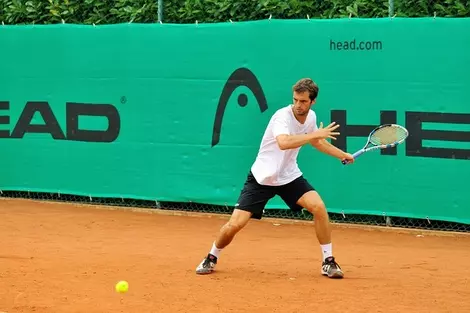Tennis requires various types of muscular strength. The strength required to make accurate shots, the speed needed to move swiftly around the course, and the stamina required to endure a challenging game. When a player has all of this is more likely to be part of the WTA standings.
Tennis requires more rotational strength, side-to-side speed, and solid shoulders than any other sport. Additionally, stronger and more flexible muscles are less likely to sustain an injury, which is crucial for most players, as they get injuries more frequently on hard surfaces than on grass or clay.
Therefore, today’s finest players also perform exercises to strengthen their muscles and joints, enabling them to execute such spectacular movements.
Here are some of the exercises;
Table of Contents
Medicine Ball Slam
In this exercise, you and a training partner traverse the court while passing a medicine ball back and forth. Both the upper and lower bodies can use it.
Slams with a medicine ball are a full-body exercise that targets the abdominal muscles. The force you use to slam the ball strengthens your core muscles and improves the power of your strokes on the court.

Even when tired, medicine ball slams need little weight training technique and provide little danger of harm.
Stand around 3 feet away from a concrete block wall. Maintain the ball on the hips. Turn your trunk away from the wall and begin the throw by pushing your hip, then your trunk, arms, and ball toward the wall.
One hand should be placed underneath the ball, while the other should be placed behind it. Ten repetitions on each side, then swap sides.
Foam Rolling
Foam rolling is a technique that utilizes deep compression to eliminate muscular knots and imbalances that develop over time. The compression soothes the nerves, relaxes the muscles, increases blood flow, and aids in the body’s recovery from workouts and daily activities.
Similar to a professional massage, foam rolling might cause discomfort. Utilize the roller to massage any area that feels tight and needs attention.
In addition to correcting muscle imbalances, the foam roller reveals the health of your muscles and connective tissues. Recovery is essential in tennis, and the foam roller will assist you in returning to the court more quickly.
Lateral Lunge
Lateral movement is a crucial aspect of the game; however, many standard strength training programs need to emphasize it. Doing this exercise will give you an added advantage over your next opponent.
Lunges work the glutes, hip abductors, knees, hips, and the remainder of the lower body. Once you have mastered the fundamental action, you can add dumbbells or a barbell to make it more difficult.
Step to the left and drop your hips by squatting with your left leg while maintaining a straight right leg. To return to the starting position, perform a left-leg push-up.
Alter your movement and perform the exercise 10 times on each side. It will strengthen your glutes, hamstrings, and quadriceps while stretching the inner thigh of your straight leg.
Goblet Squat
Squats are one of the essential lower-body workouts, and goblet squats are an excellent version for novice and advanced athletes.
Goblet squats target the quadriceps and glutes in addition to the core and arms. This makes them beneficial for tennis players who wish to work all their muscles.
How to proceed: Your feet should be shoulder- or hip-width apart and pointed straight ahead. To hold the kettlebell at chest height, tense your core and grasp the grip’s sides. Draw the kettlebell close to your body by pressing your shoulder blades together.
Put your hips back and bend your knees to get into a squat position. Keep your chest up and squat as low as possible while maintaining a straight back. If your back begins to round, your stance is too low.
As you return to a tall standing position, apply pressure through your feet and contract your glutes.
Have Rest Days
Without sufficient rest, the body cannot physically recoup, regenerate itself, or transform. This includes the muscle tissue, neurological system, and immunological system.
Tennis players train to improve their performance (which is what we are looking for); when training loads increase, performance increases (over time, gradually working at higher intensities, with greater loads – fluctuating durations and frequency).
It is only possible to complete more work if regular rest and recovery periods occur. This concept is termed “training periodization.”
Overtraining in tennis occurs when intense training continues without adequate recovery. This causes a decline in performance or an injury that requires several days or weeks to heal.
